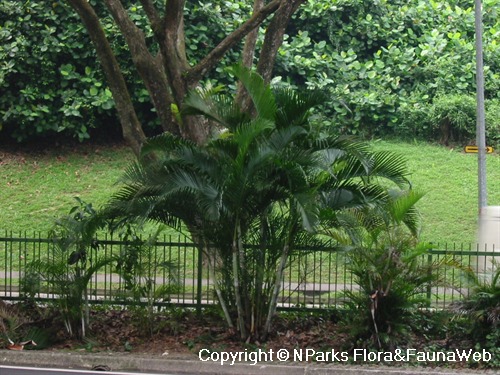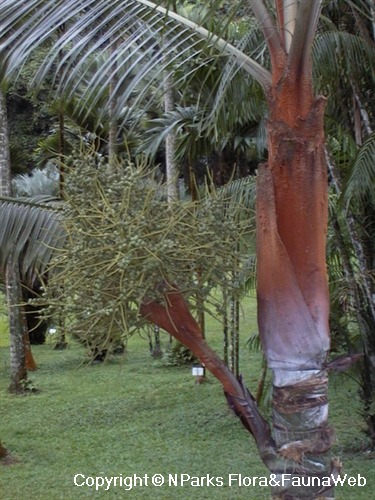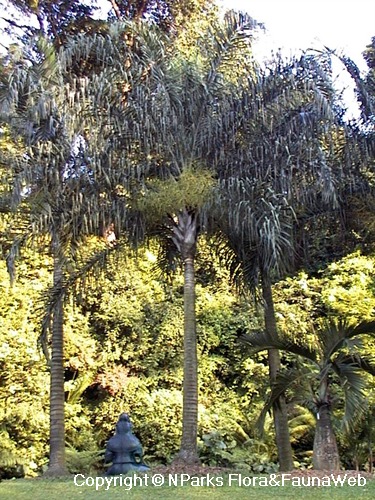
Back
Chrysalidocarpus lutescens H.Wendl.
| Family Name: | Arecaceae (Palmae) |
| Synonyms: | Dypsis lutescens (H.Wendl.) Beentje & J.Dransf., Chrysalidocarpus baronii var. littoralis Jum. & H.Perrier |
| Common Name: | Yellow Cane Palm, Yellow Areca Palm, Areca Palm, Golden Cane Palm, Butterfly Palm, Golden Fruited Palm, Madagascar Palm, Yellow Palm, Pinang Kuning, Bamboo Palm |
Name
Classifications and Characteristics
| Plant Division | Angiosperms (Flowering Seed Plants) (Monocotyledon) |
|---|---|
| Plant Growth Form | Palm (Clustered Habit) |
| Mode of Nutrition | Autotrophic |
| Maximum Height | 8 m |
| Maximum Plant Spread / Crown Width | 5 m |
Biogeography
| Native Distribution | Madagascar |
|---|
Description and Ethnobotany
| Growth Form | A slender, small to medium-sized, clustering or clumping palm with multiple cane-like stems that bears recurving, pinnate fronds with a prominent elevated midrib. |
|---|---|
| Trunk | Stem smooth, up to 7.5 cm in diameter, greyish-green, ringed with distinct leaf scars; crownshaft yellowish-green. |
| Foliage | Fronds pinnate, yellowish-green to bright green (usually the older fronds will have leaflets with yellowish tips), spirally-arranged, soft, gracefully arching outward and downward, 1.6 to 2 m long, consisting of about 40 to 50 pairs of narrowly lanceolate leaflets. |
| Flowers | Inflorescences yellow, occurring at the base of the crownshaft. |
| Fruit | Fruits oblong, about 1.7 cm long, asymmetric, ripening from yellow to purple. |
| Cultivation | Suitable to grow in sun or shade but looks best in bright diffused light. Prefers well-drained, moist and fertile soil. Prefers the soil pH to be mildly acidic (pH 6.1 to 6.5). Fairly drought tolerant. Can be heavy feeders thus, fertilize monthly with water soluble fertilizer or granular slow-release fertilizer. Drench the soil and allow it to be moderately dry between waterings. Susceptible to mealy bugs, scales and mites. Suitable to use as an indoor plant. Growth is limited when potted or taken indoors. Propagate by seeds and division of clumps. Before harvesting seed, the unblemished fruit should be over-riped. Seeds, which will take about 2 to 6 months to germinate, have low storage life thus should be sown immediately. Offshoots or suckers can be cut from the base of mature stems and used to start new plants. An ideal sucker of 30 cm with some root growth can be taken out and grown as a new plant. |
| Etymology | The species epithet 'lutescens' comes from the latin word 'lutens', which refers to yellowish or yellow, in reference to its yellowish appearance on the stems and midribs. |
| Ethnobotanical Uses | Others: Fronds can be used in flower arrangement. |
Landscaping Features
| Landscape Uses | Interiorscape/ Indoor Plant |
|---|
Plant Care and Propagation
| Light Preference | Semi-Shade, Full Sun |
|---|---|
| Water Preference | Moderate Water |
| Plant Growth Rate | Moderate |
Foliar
| Mature Foliage Colour(s) | Green |
|---|---|
| Leaf Area Index (LAI) for Green Plot Ratio | 4.0 (Palm - Cluster) |
Non - Foliar and Storage
| Trunk Type (Palm) | Clustering Habit, Aboveground |
|---|
Floral (Angiosperm)
| Flower Colour(s) | Yellow / Golden |
|---|
Fruit, Seed and Spore
| Mature Fruit Colour(s) | Purple |
|---|
References
| References | Eiserhardt, W.L., Bellot, S., Cowan, R.S., Dransfield, J., Hansen, L.E., Heyduk, K., Rabarijaona, R.N., Rakotoarinivo, M. & Baker, W.J. (2022). Phylogenomics and generic limits of Dypsidinae (Arecaceae), the largest palm radiation in Madagascar. Taxon 71(6): 1170–1195. |
|---|
Image Repository
Others
| Master ID | 1329 |
|---|---|
| Species ID | 2622 |
| Flora Disclaimer | The information in this website has been compiled from reliable sources, such as reference works on medicinal plants. It is not a substitute for medical advice or treatment and NParks does not purport to provide any medical advice. Readers should always consult his/her physician before using or consuming a plant for medicinal purposes. |


